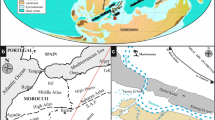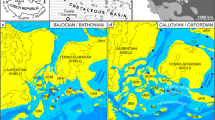Abstract
Characteristic latest Neoproterozoic and Early Paleozoic acritarchs and associated organic-walled microfossils are recorded from the sediments of Marwar Supergroup encountered in BGW-A well (Bikaner-Nagaur Basin) from 1123–481 m depth. Six distinct acritarch assemblages, broadly comparable with globally known Ediacaran (Vendian) and Cambrian assemblages are recognised. The recovered microfossils provide precise age for different units of the Marwar Supergroup whose ages, till now, were poorly understood due to absence or paucity of invertebrate and other mega and microfossils.
Jodhpur Group (1123–1105 m), the basal unit of Marwar Supergroup, records abundant ornamented sphaeromorphs (Lophosphaeridium spp.) alongwith various species of Leiosphaeridia, suggesting Late Ediacaran age. Occurrence of small micrhystrids (Asteridium spp.) and appearance of Dictyotidium birvetense, Pterospermella solida and Annulum squamaceum in lower part of Bilara Group (1105–1081 m), suggests latest Ediacaran to early Early Cambrian age. Hanseran Evaporite Group (1068–907m) is marked by abundant Retisphaeridium dichamerum, Dictyotidium birvetense, Cristallinium cambriense, Comasphaeridium sp. cf. C. strigosum and Archaeodiscina umbonulata indicating late Early Cambrian to early Middle Cambrian age. Microfossil contents in Nagaur Group (907–727m) are very poor. The succeeding Upper Carbonate Sequence (727–481 m) shows abundant Cristallinium randomense, Cymatiosphaera crameri and Asteridium spp., along with other species of Cymatiosphaera and Cristallinium, and also includes the early Late Cambrian marker forms, such as Striatotheca loculifera and Dorsenidium (Veryhachium) minutum that suggest late Middle Cambrian to early Late Cambrian age.
The recorded acritarch assemblages suggest Late Ediacaran to early Late Cambrian (ca 570–500 Ma) age for the Marwar Supergroup, with demarcation of Precambrian-Cambrian boundary within the lower part of Bilara Group. Associated microfossils indicate intertidal/foreshore depositional environment for Jodhpur and Nagaur groups, whereas inner neritic to subtidal for the Bilara, Hanseran and Upper Carbonate units. Occurrence of an Early Permian palynoflora in the succeeding sequence (481–427 m depth) indicates a major hiatus of ca 200Ma between the Marwar and overlying Bap/Badhaura sequences which involves the absence of middle Late Cambrian to Late Carboniferous sediments in this basin.
Latest biostratigraphic data from Ujhani (Ganga Basin) and Bhander (Vindhyan Basin) sediments suggest that the above two sequences are closely comparable with the Marwar Supergroup, and show the prospective exploration challenges as do the Marwar Supergroup.
Similar content being viewed by others
References
Bharadwaj, D.C., Srivastava, S. and Prakash, A. (1979) Palynostratigraphy of the Talchir Formation from Mannendragarh, Madhya Pradesh, India. Geophytology, v.8(2), pp.215–225.
Burman, G. (1980) An analysis of the Marwar Basin, Western Rajasthan, in the light of stromatolite study. Geol. Surv. India. Misc. Publ., no.47, pp.292–302.
Burzin, M.B. (1996) Late Vendian (Neoproterozoic III) microbial and algal communities of the Russian Platform: models of facies-dependent distribution, evolution and reflection of basin development. Revista Ital. Paleontol. Stratigraf., v.102, pp.307–316.
Crawford, A.R. and Compston, W. (1970) The age of the Vindhyan System of Peninsular India. Quart. Jour. Geol. Soc. London v.125, pp.351–371.
Dasgupta, S.P., Kumar, V., Ramachandra and Jairam, M.S. (1988) A framework of the Nagaur-Ganganagar evaporate basin, Rajasthan. Indian Minerals, v.42(1), pp.57–64.
Dasgupta, U. and Bulgauda, S.S. (1994) An overview of the geology and hydrocarbon occurrences in the western part of Bikaner-Nagaur Basin. Indian Jour. Petroleum Geol., v.3(1), pp.1–17.
Dey, R.C. (1991) Trans Aravalli Vindhyan Evaporites under the semi-desertic plains of western India-Significance of depositional features. Jour. Geol. Soc. India, v.37, pp.136–150.
Dickins, J.M. and Shah, S.C. (1979) Correlation of the marine Permian sequences of India and western Australia. Proc. IVth Internat Gondwana Symp., v.2, pp.387–408.
Downie, C. (1984) Acritarchs in British stratigraphy. Geol. Soc. London, Spec. Report no.17, pp.1–26.
GSI (1979) Group discussions on Annual Programme of Geological Survey of India, Western Region, 1978–79, 18–23 September, 1978, Jaipur, p.77.
Gradstein, F.M., Ogg, J.G., Smith, A.G., Bleeker, W. and Lourens, L.J. (2004) A new Geologic Time Scale, with special reference to Precambrian and Neogene. Episodes, v.27(2), pp.83–100.
Khan, B.A. (1973) Discovery of Fossil Brachiopods of Cambrian affinity from Trans-AravalliVindhyan Sequence, near Jodhpur, Rajasthan. Sem. on Recent Advances in the Geology of Rajasthan and Gujarat, Abstract, pp.74–75.
Kumar, S. and Pandey, S.K. (2008a) Discovery of trilobite trace fossils from the Nagaur Sandstone, the Marwar Supergroup, Dulmera area, Bikaner district, Rajasthan. Curr. Sci., v.94, pp.1081–1085.
Kumar, S. and Pandey, S.K. (2008b) Arumbaria and associated fossils from the Neoproterozoic Maihar Sandstone, Vindhyan Supergroup, Central India. Jour. Paleontol. Soc. India, v.53, pp.83–97.
Lele, K.M. and Chandra, A. (1972) Palynology of the marine intercalations in the Lower Gondwana of Madhya Pradesh, India. Paleobotanist, v.19, pp.253–262.
Lukose, N.G. (1972) Palynological evidences on the age of Lathi Formation, Western Rajasthan, India. Sem. Paleopalynology Indian Stratigraphy, Calcutta University, Calcutta, pp.155–159.
Lukose, N.G. (1974) Palynology of the subsurface sediments of the Manehara Tibba Structure, Jaisalmer, western Rajasthan, India. Paleobotanist, v.21, pp.285–297.
Mehrotra, N.C., Babu, R., Tiwari, R., Jha, N. Kumar, P., Singh, V.K. and Shukla, M. (2008) New global opportunities for hydrocarbon exploration in Neoproterozoic basins of Indian subcontinent. Jour. Geol. Soc. India, v.72(4), pp.543–546.
Misra, P.C., Singh, N.P., Sharma, D.C., Upadhyay, H. Kakroo, A.K. and Saini, M. L. (1993) Lithostratigraphy of Indian Petroliferous Basins. Document II. West Rajasthan Basins. KDMIPE, ONGC, Dehradun, pp.1–29.
Maithy, P.K. (1984) Microbiota from Stromatolite-Stratifera of the Bilara Group (Marwar Supergroup), Western Rajasthan. Paleobotanist, v. 32(1), pp.82–85.
Martin, F. and Dean, W.T. (1981) Middle and Upper Cambrian and Lower Ordovician acritarchs from Random Island, eastern Newfoundland. Geol. Surv. Canada Bull., v.343, pp.1–43.
Martin, F. and Dean, W.T. (1988) Middle and Upper Cambrian acritarchs and trilobite zonation at Manuels river Random Island, eastern Newfoundland. Geol. Surv. Canada, Bull., v.381, pp.1–91.
Moczydlowska, M. (1991) Acritarch biostratigraphy of the Lower Cambrian and the Precambrian-Cambrian boundary in Southeastern Poland. Fossil & Strata, v.29, pp.221–254.
Moczydlowska, M., Vidal, G. and Rudavaskaia, V. A. (1993) Neoproterozoic (Vendian) phytoplankton from the Siberian Platform, Yakutia. Paleontology, v. 36, pp.495–521.
Molyneux, S.G., Le Herisse and Wicander, R. (1996) Chapter 16. Paleozoic phytoplanktons; In: J. Jansonius and D.C. McGregor (Eds.), Palynology: Principles and applications. American Association of Stratigraphic Palynologists Foundation, v.2, pp.493–529.
Pareek, H.S. (1981) Basin configuration and sedimentary stratigraphy of western Rajasthan. Jour. Geol. Soc. India, v.22, pp.517–527.
Pareek, H.S. (1984) Pre-Quarternary geology and mineral resources of northern Rajasthan. Mem. Geol. Surv. India, v.115, pp.1–41.
Peters, K. E., Clark, M. E., Dasgupta, V. McCaffrey, M. A. and Lee, C. Y. (1995) Recognition of an Infracambrian source rock based on biomarkers in the Bhagewala-1. Oil India. AAPG Bull., v.79(10), pp.1482–1494.
Prasad, B. (1996) Palynology of the Draksharama Argillite, Krishna-Godavari Basin. Contr. XV Colloq. Micropalaenotol. Stratigr. KDMIPE, Dehra Dun, pp.577–589.
Prasad, B. (2007) Obruchevella and other Terminal Proterozoic (Vendian) organic-walled microfossils from the Bhander Group (Vindhyan supergroup), Madhya Pradesh, India. Jour. Geol. Soc. India, v.69(2), pp.295–310.
Prasad, B. and Asher, R. (2001) Acritarch biostratigraphy and lithostratigraphic classification of the Proterozoic and Lower Paleozoic sediments (Pre-Unconformity Sequence) of Ganga Basin, India. Paleontographica Indica, no.5, KDMIPE, ONGC, Dehradun, pp.1–155
Prasad, B., Uniyal, S.N. and Asher, R. (2005) Organic-walled microfossils from the Proterozoic Vindhyan Supergroup of Son Valley, Madhya Pradesh, India. Paleobotanist, v.54, pp.13–60.
Raghav, K.S., De, Chirananda and Jain, R.L. (2005) The first record of Vendian medusoids and trace fossil-bearing algal metagrounds from the basal part of the Marwar Supergroup of Rajasthan, India. Indian Minerals, v.59(1&2), pp.23–30.
Rathore, S.S., Venkatesan, T.R. and Srivastava, R.K. (1999) Rb-Sr isotope dating of Neoproterozoic (Malani Group) magmatism from southwest Rajasthan: Evidence for a younger Pan-African thermal event by 40Ar-39Ar studies. Gondwana Res., v.2, pp.271–281.
Roy, A.B. and Jakhar, S.R. (2002) Geology of Rajasthan (Northwest India): Precambrian to Rrecent. Scientific Publisher (India), Jodhpur.
Sastri, M.V.A. and Moitra, A.K. (1984) Vindhyan Stratigraphy-A review. Mem. Geol. Surv. India, v.116, pp.109–148.
Shiekh, Riaz A., Jamil, M. Athar, Mccann, Jim and Saqi, M.I. (2003) Distribution of Infracambrian reservoirs on Punjab Platform in Central Indus Basin of Pakistan. Proc. ATC 2003 Conf. and Oil Show, Islamabad, pp. 1–17.
Torsvick, T.H., Carter, L.M., Aswal, L.D., Bhushan, S.K. and Jamtveit, B. (2001) Rodenia redefined or obscured: Paleomagnitism of the malani Igneous Suite, NW India. Precambrian Res., v.108, pp.319–333.
Vanguestaine, M. and Van Looy, J. (1983) Acritarches du Cambrien moyen de la Vallede Tacheddirt (haut-Atlas, Maroc) dans le cadre d’une nouvelle zonation du Cambrien. Anneles de la Societe Geologique de Belgique, v.106, pp.69–85.
Venkatachala, B.S. and Rawat, M.S. (1984) Palynofossils from the Bap Formation, Rajasthan, India. Bull. ONGC, v.21, pp.61–68.
Vidal, G. (1976a) Late Precambrian microfossils from the Visingso Beds in southern Sweden. Fossil and Strata, v.9, pp.1–57.
Vidal, G. (1976b) Late Precambrian acritarchs from the Eleonore Bay Group and Tillite Group in East Greenland. Gronlands Geologiske Undersogelse Rapport, v.78, pp.1–19.
Vidal, G. (1981) Micropalaeontology and biostratigraphy of the Upper Proterozoic and Lower Cambrian sequence in East Finnmark, northern Norway. Norges Geologiske Undersogelse Bull., v.362, pp.1–53.
Vidal, G. and Knoll, A.H. (1983) Proterozoic plankton. Mem. Geol. Soc. America, v.161, pp.265–277.
Volkova, N. A. (1968) Acritarchs from the Precambrian and Lower Cambrian deposits of Estonia. In: N. A. Volkova, Z. A. Zhuravleva, V. E. Zabrodin and B. Klinger (Eds.), Problematic Riphean-cambrian layers of the Russian Platform, the urals and Kazakhstan. Trudy Geologischeskogo Instituta, Akademia Nauk SSSR, Nauka, Moscow, v.188, pp.8–36.
Volkova, N.A. (1985) Acritarchs and other plant microfossils from the East European Platform. In: B.S. Sokolov and A.B. Ivanovsky (Eds.), TheVendian System 1. Paleontology Nauka, Moscow, pp.130–139.
Volkova, N.A., Kir’ianov, V.V., Piscun, L.V., Paskeviciene, L.T. and Jankauskas, T.V. (1979) Plant microfossils. In: B.M. Keller and Rozanov, A.IU. (Eds.), Upper Precambrian and Cambrian Paleontology of the East European Platform. Nauka, Moscow, pp.4–38.
Volkova, N.A., Kir’ianov, V.V., Piscun, L.V., Paskeviciene, L.T. and Jankauskas, T.V. (1983) Plant microfossils. In: A. Urbanek and A.IU. Rozanov (Eds.), Upper Precambrian and Cambrian paleontology of the East European Platform. Wydawnictwa Geologiczne, Warsaw, pp.4–46.
Young, T., Martin, F., Dean, W.T. and Rushton, A.W.A. (1994) Cambrian stratigraphy of St Tundwal’s Peninsula, Gwynedd, northwest Wales. Geol. Mag., v.131(3), pp.335–360.
Author information
Authors and Affiliations
Corresponding author
Rights and permissions
About this article
Cite this article
Prasad, B., Asher, R. & Borgohai, B. Late Neoproterozoic (Ediacaran)-Early Paleozoic (Cambrian) acritarchs from the Marwar Supergroup, Bikaner-Nagaur Basin, Rajasthan. J Geol Soc India 75, 415–431 (2010). https://doi.org/10.1007/s12594-010-0038-4
Received:
Accepted:
Published:
Issue Date:
DOI: https://doi.org/10.1007/s12594-010-0038-4




